Calls to a particular extension are not routing to voicemail. The user reaches the voicemail system from the handset by pressing the Messages button Which configuration parameter causes this problem?
What are two configureation features of the Client matter code setting in the route pattern configuration? (Choose two.)
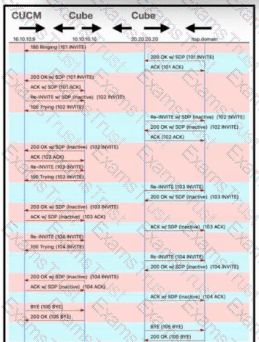
Refer to the exhibit. During a troubleshooting session, an engineer was presented with this call flow output diagram after a user reported issues with a call via the SIP ITSP to a counterpart. What is occurring with this call flow?
Which call pickup feature allows users to pick up incoming calls in a group that is associated with their own group?
An engineer must configure call queuing under a Hunt Pilot. After the engineer receives the audio file that will be played to callers during queuing, which two steps should be taken to complete the configuration? (Choose two.)
An administrator sees the voice register pool 1 command in a Cisco UCME configuration. Which configuration is occurring in this section?
An engineer is configuring a Cisco UCM solution. The requirements state that some users in one location will receive calls from a number during work hours 09AM to 5PM, and another group will get the calls from the same number outside this defined timeslot. Users will also change the outgoing number when reaching out to customers based on the same time-of-day routing rules. Which feature is needed to allow for this type of configuration?
An engineer is configuring call queuing to place callers in a queue until hunt members are available to answer them. The engineer also must set the option to automatically log off an agent that does not answer a queuing-enabled hunt pilot call.
Which Cisco UCM menu is used to accomplish this goal?
A company is using a H.323 gateway for PSTN calls from Cisco phones connected to a Cisco UCM cluster. There are reports of problems getting audio on these incoming calls from the PSTN. The phone rings, but nothing is heard and the call disconnects.
Which command troubleshoots this issue?
An administrator deployed a third-party H.323 gateway in a voice environment, but users report call failures when using features like call hold or call transfer. What are two reasons that these features fail? (Choose two.)
What does VoIP trace in a Cisco Unified Border Element do?
Which top-level IOS command is needed to begin the configuration of a Cisco Unified Communications Manager Express gateway to enable phones to be registered via SIP?
An engineer configured extension mobility to allow users to roam between phones while taking their numbers and specific device settings with them. Users are now getting "Error:- XML Error [4| Parse Error" on their phones. Which action will resolve this issue?
When configuring hunt groups, where does the administrator add the individual directory numbers that should be part of the group?
An engineer is troubleshooting local ringback on a Cisco SIP gateway The gateway is not ignoring the SIP 180 response with SDP from the service provider, and the far end device is sending the 180 with SDP to play ringback from the IP address specified m the SDP Which configuration change must be made on the gateway to resolve the issue?
An organization needs to ensure that the Cisco UCM can provide a resume softkey to users on their desk phones when they disconnect an anchored call on their mobile phone. Which solution must be used to accomplish these goals?
Refer to the exhibit.
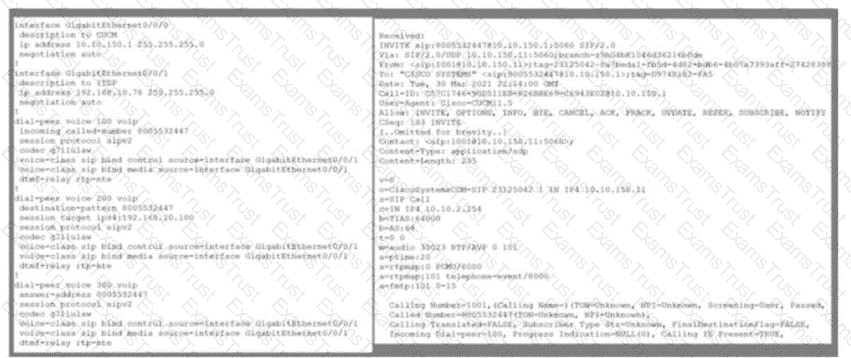
An engineer is troubleshooting a call-establishment problem between Cisco Unified Border Element and Cisco UCM. Which command set corrects the issue?
A single site reports that when they dial select numbers, the call connects, but they do not get audio. The administrator finds that the calls are not routing out of the normal gateway but out of another site's gateway due to a TEHO configuration. What is the next step to diagnose and solve the issue?
An engineer is configuring a Cisco Collaboration system for SIP endpoints and must enable Survivable Remote Site Telephony for these endpoints. Which code completes this configuration on the SRST gateway?
A)

B)

C)
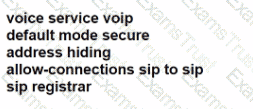
D)

Signal number reach call phone that not answered are leaving voicemails on the cell phone rather the corporate mailbox. Which two options will resolve this issue? (Choose two.)
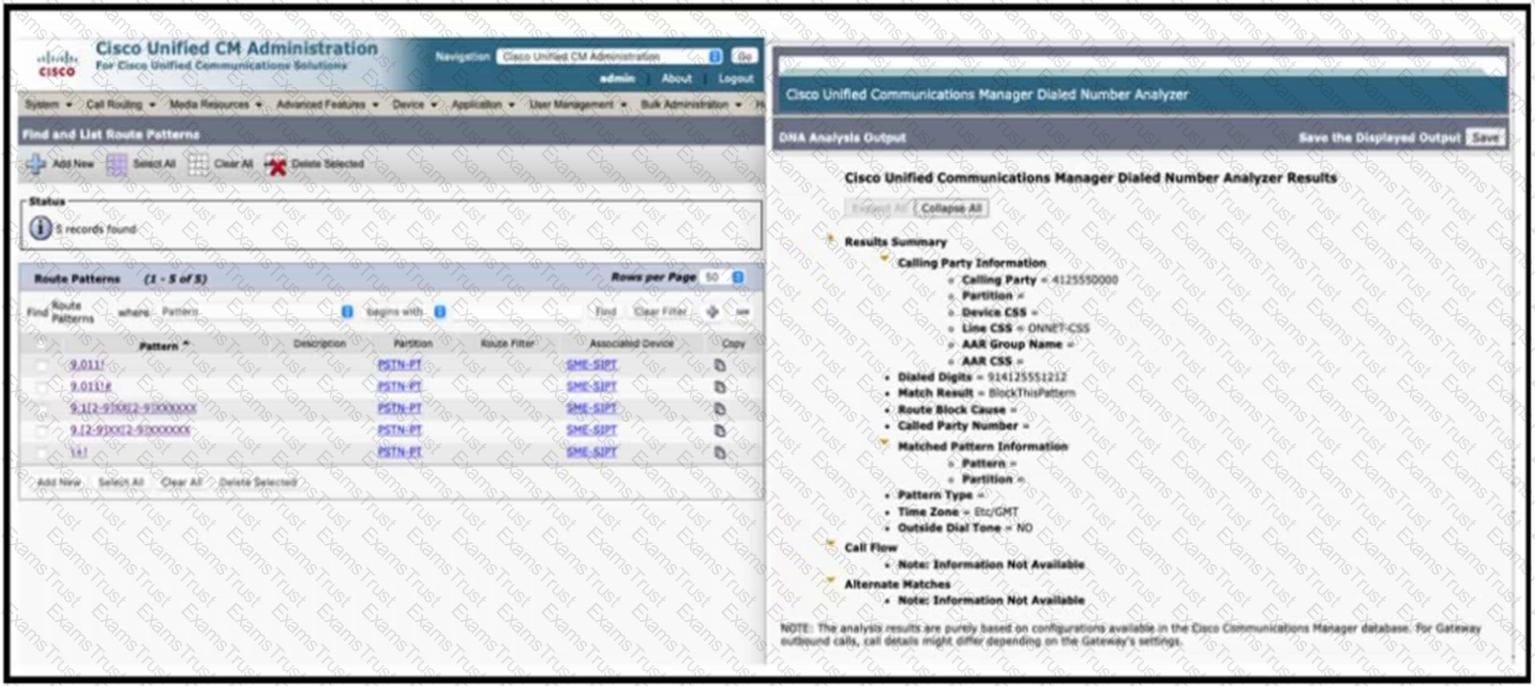
Refer to the exhibit. A collaboration engineer is troubleshooting an issue where a user of a Cisco UCM IP phone reports failed calls when trying to dial out to the PSTN. Which action resolves the issue?
An organization needs a solution to meet these requirements for its Cisco UCM system:
Modify calling party numbers for outbound calls.
Add a prefix for internal calls.
Normalize incoming calls to a consistent format.
Apply different patterns for different device pools.
Which Cisco UCM feature must be used to accomplish these goals?

Refer to the exhibit. An engineer troubleshoots why a new SIP trunk does not come up on Cisco UCM. Which action resolves this issue?
When you troubleshoot H.323 call setup, which message informs you that the called party is being notified about the call?
An administrator has a requirement that the agents that receive calls from PSTN now must have a queue to hold the calls until they can be answered, but the customer cannot afford a contact center solution. The administrator discovered a feature called Native Call Queueing on Cisco UCM. Where must the administrator configure Native Call Queueing functionality?
Refer to the exhibit.
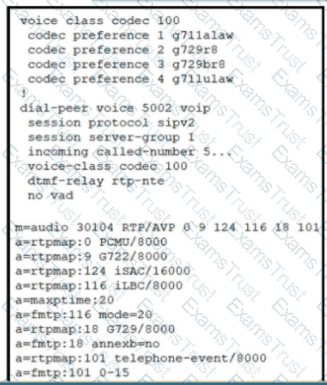
The Cisco Unified Border Element receives an INVITE matching inbound dial peer 5002. The outbound dial peer supports only iLBC. and a Local Transcoding Interface is allocated. Based on the configuration and SDP from the INVITE message, which codec is chosen by Cisco Unified Border Element for the inbound call leg?
A newly deployed site in Pennsylvania uses SIP-to-SIP legs on a Cisco Unified Border Element. The administrator wants to match the incoming dial peer based on the calling number. Which configuration is needed in the dial-peer?
Refer to the exhibit.

A collaboration engineer is troubleshooting an issue where external callers cannot leave voicemail messages. Also, internal users report hearing the reorder tone (fast busy) when they attempt to retrieve voicemail messages from their Cisco IP phones. Which action resolves the issue?
An engineer Is configuring a Cisco Unified Border Element. The SIP ITSP requires a DNIS of 10-digits and DTMF tones sent in the RTP stream on the outbound leg of a call. Which code completes this configuration?
A)

B)

C)

D)
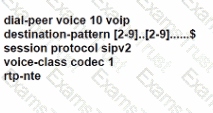
Where is the dtmf-relay command configured on Cisco Unified Border Element?
A new Cisco UCM deployment is configured, and now the customer requires a set of 10 DNSs to park the calls starting with 8. The users must use the softkey to park the call. Which configuration must be performed to achieve this requirement?
A)

B)

C)

D)

An SRST site must use pickup functionality on the Chicago remote site to allow the users to take incoming calls. The pickup command is configured under the call-manager-fallback section on the SRST router What are two results of that configuration? (Choose two.)
Refer to the exhibit.

Users report high delays when calling national numbers in the United States. An engineer analyzes the route patterns in Cisco UCM. What must be done to resolve this issue?
An organization configures a SIP trunk in Cisco UCM to connect to another system. These requirements must be met:
1. Use a specific IP address for SIP signaling.
2. Encrypt the signaling traffic.
3. Restrict which devices can use the SIP trunk. 4 Simplify SIP signaling.
Drag and drop the Cisco UCM configuration steps from the left onto the order on the right to achieve these goals.

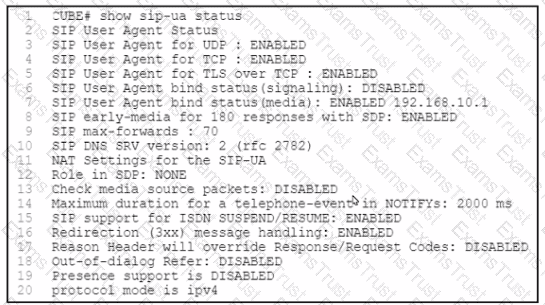
Refer to the exhibit An engineer deploys a Cisco Unified Border Element for SIP trunk interconnection to an ITSP The engineer performs test calls but there is no audio when the called party picks up the phone. What must the engineer do to resolve the issue?
What are the elements for Device Mobility configuration?
For s SIP to SIP call flow, when does Cisco Unified Border Element require transcoding resources for DTMF?
Which configuration must an administrator perform to display Translation Pattern operations in Cisco Unified Communications Manager SDL traces?
An administrator is implementing a new dial-plan on Cisco Unified Border Element. The administrator must ensure that incoming dial-peers are matched based on the IP address from where the incoming request originates. Which dial-peer configuration should be applied to accomplish this requirement?
Configure Call Queuing in Cisco Unified Communications Manager. Where do you set the maximum number of callers in the queue?
Users report that calls to some locations do not work. The phone is calling, the recipient picks up, but it does not connect. These users are in the headquarters and registered to the company Cisco UCM with default values for calling (G.711). The problem locations are smaller remote locations with low bandwidth capacity, so the phones are configured with iLBC.
Which command should be used to troubleshoot the issue?
An engineer is configuring Cisco UCME to support SIP endpoints. The engineer wants to limit the system to 20 SIP phones and 50 directory numbers. Which code completes this configuration?
A user reports when they press the services key they do not receive a user ID and password prompt to assign the phone extension. Which action resolves the issue?
A Collaboration engineer is implementing call processing capabilities on the Cisco UCM and needs to configure Call Queuing to place callers in a queue until hunt members are available to answer them. Which action must be completed before this feature can be configured?
Refer to the exhibit.

Which INVITE is sent to 10.10.100.123 as a result of this log?
A)

B)

C)

D)

Refer to the exhibit.
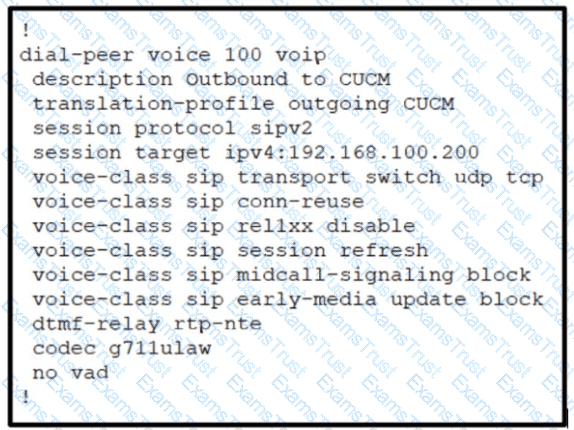
An engineer is troubleshooting an issue where inbound calls to Cisco UCM with early media fail to establish. While investigating the issue, the engineer finds that Cisco UCM is set to require a PRACK. but the Cisco Unified Border Element is not sending it. Which command is causing this issue?
An administrator must control the number of calls to a remote specific site to reduce bandwidth constraints. The users on that remote site report bad quality of the calls passing through that WAN link. Which action must the administrator take in Cisco UCM to resolve the issue?
A company wants to optimize the ability to answer the phone for customers that call different departments. Each of the three departments consists of five people. The company needs a simple round-robin style queue for each department to ensure that the phone rings to a new person after four rings each. What is the most efficient configuration to meet this requirement?
Refer to me exhibit.
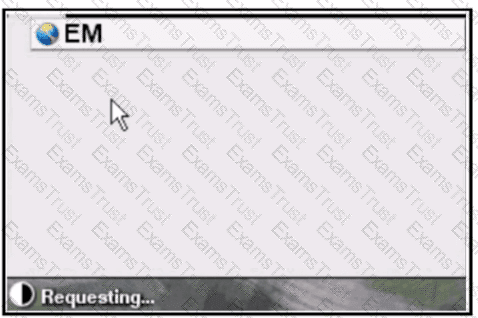
A user cannot access Extension Mobility even after clicking the services button and selecting EM service. There is nowhere to place the username and password to sign In for this service. What Is the cause of the issue?
Which section under the Real-Time Monitoring Tool allows for reviewing the call flow and signaling for a SIP call in real time?
Drag and drop the commands from the bottom to the blanks in the code to implement a translation rule to allow only 11 digits to be received over a SIP trunk to a SIP provider. The Cisco UCM is currently sending calls to the Cisco Unified Border Element in E. 164 format. Not all options are used.
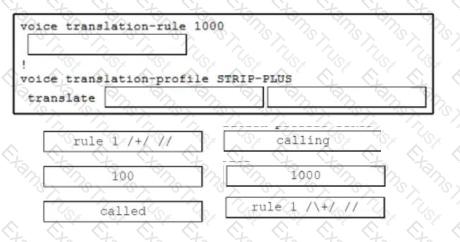
A company is using Cisco Jabber on-premises to make B2B calls on video. The calls are using Cisco Expressway-C and Expressway-E and have been configured in Cisco UCM to be able to call any URI on the internet. The Jabber client also has voice enabled and must be able to call local, regional, and international numbers. Where must Cisco UCM be configured to meet this requirement for URI dialing?
Refer to the exhibit.
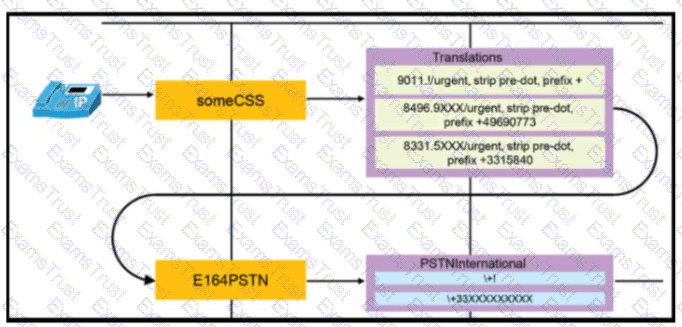
A user dials 84969010 and observes that the call is not routed immediately. The administrator notices that after matching the fixed-length translation pattern, the call hits the \+! pattern and waits for interdigit timeout What should be configured to ensure that the call routes out immediately?
Refer to the exhibit.
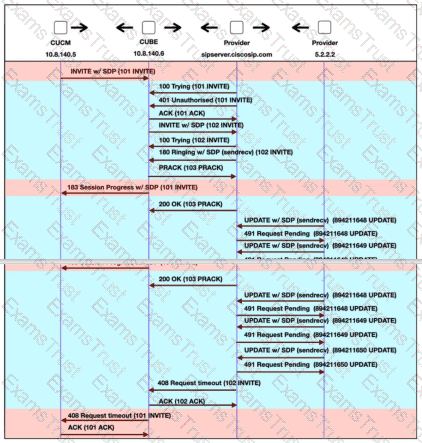
A Cisco Unified Border Element continues to send 180/183 with the required: 100rel header to Cisco UCM. and the call eventually disconnects How is the issue resolved?
The company Cisco UCM cluster has two different gateways for off-net calls. The current configuration uses 9 as a prefix to get to the main gateway. The secondary gateway is for any calls that start with 9713, but this is not yet configured. The admin does not want to add more route patterns other than the current 9 prefix for the gateway to the Cisco UCM. How must the Cisco UCM be configured to meet the requirements?
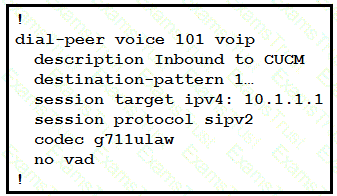
Refer to the exhibit. When setting up a new connection to Cisco UCM, the engineer must use out-of-band DTMF. Which configuration meets this requirement?
A user has a problem calling a specific PSTN number. An engineer investigates the issue on a Cisco UCM server and a Cisco Unified Border Element router, and discovers that the ITSP rejects the outbound SIP INVITE with a 422 Session Timer Too Small SIP message. What must the engineer do to resolve the issue?
Users in a small location report that audio calls work Tine, but only one video call works before the next one gets a busy signal. Three video conference rooms were recently installed by a third party. The audio and video devices are Cisco endpoints. The site uses video and audio calls, and a network investigation does not show saturation on the link The site is configured with QoS and CoS. All devices are registered on the headquarters Cisco UCM duster. What is the cause of this problem?
A company has users that frequently visit locations outside the office. These users need to be able to make calls and keep the company integrity by presenting a company caller ID. The users are equipped with company-paid mobile phones. The company uses Cisco UCM with Cisco Unified Border Element and Expressway-C and Expressway-E for external communications. Which technology must be configured to meet this requirement?
Refer to the exhibit.
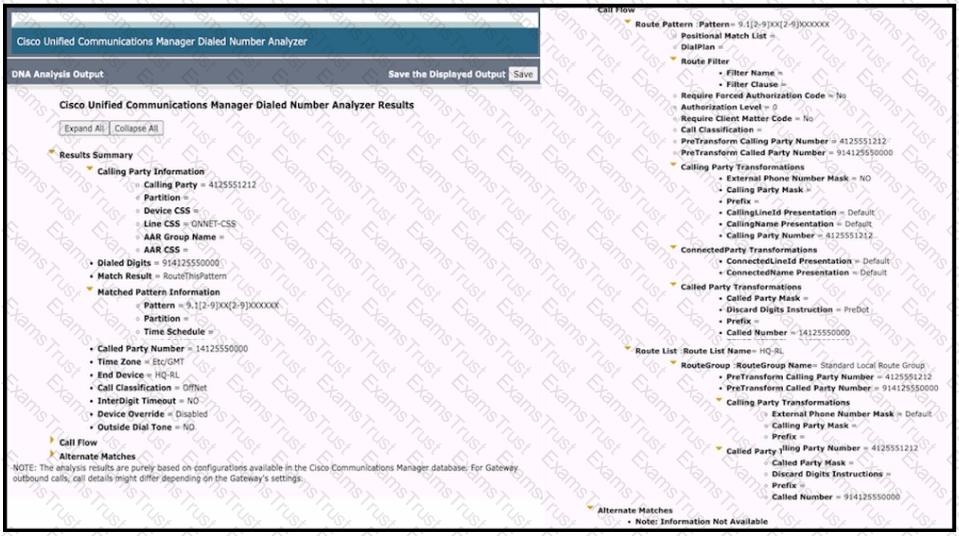
A collaboration engineer is troubleshooting an issue where the PSTN calls of a Cisco UCM IP phone user are not reaching the PSTN gateway. Which action resolves the issue?
Some users report poor quality when they travel to another continent and make calls. This issue applies only to one continent and not to others, where typically the dialing is fast and quality is clear. Users experience the same result at home when they call the same numbers in that specific continent. It seems like some users do not exist in the correct PSTN gateway when making calls to a specific country. The company is using TEHO to save on the cost of international or long-distance calling.
They are also using a globalized dial plan. What is the cause of the issue?
A support engineer is troubleshooting a voice network. When conducting a search for call setup details related to calling search space issues, which trace files should be investigated?
A Collaboration engineer wants to deploy Global Dial Plan Replication for advertising its global dial plan data, including the global dial plan data that was configured locally and any data that was learned from other clusters. The engineer is configuring the inter-cluster lookup service on the Cisco UCM and activated the ILS service and configured the cluster IDs.
What is the next step in the configuration?
A company wants to use a Cisco phone system without the need for a local generic server. It is maximum 30 phones using a vendor-independent, industry-standard call protocol. What is the first command that must be entered to add this type of phone when registering a Cisco phone to this device?
Refer to the exhibit.
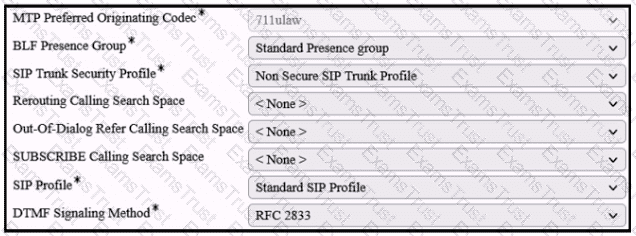
An administrator just Implemented SIP trunking on their Cisco UCM and reports that calls using the SIP trunk are using Media Termination Point resources unnecessarily. Which action resolves the issue?
Refer to the exhibit.
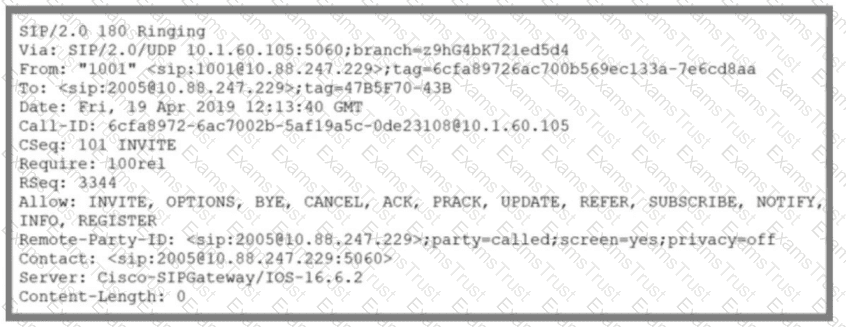
An engineer is troubleshooting an issue with the caller not hearing a PSTN announcement before the SIP call has completed setup. How must the engineer resolve this issue using the reliable provisional response of the SIP?
The company implemented Cisco Unified Mobility on the Cisco UCM. The users are satisfied and can transfer voice calls between devices. Mobile users want to extend the timer that controls the time given to pick up a voice call on an IP phone from 4 to 6 seconds. Which configuration change satisfies this requirement?
Which description of RTP timestamps or sequence numbers is true?
An engineer has temporarily disabled toll fraud prevention for SIP line calls on a Cisco CME12.6x and must enforce security and toll fraud prevention for the SIP line side on Cisco Unified CME. Which configuration must be used to start this process?
If all patterns below are configured in Cisco Unified Communications Manager which would be used when dialing the pattern “123”?
An administrator is troubleshooting call failures on an H.323 gateway via the CLI. To see signaling for media and call setup, which debug must the Administrator turn on?
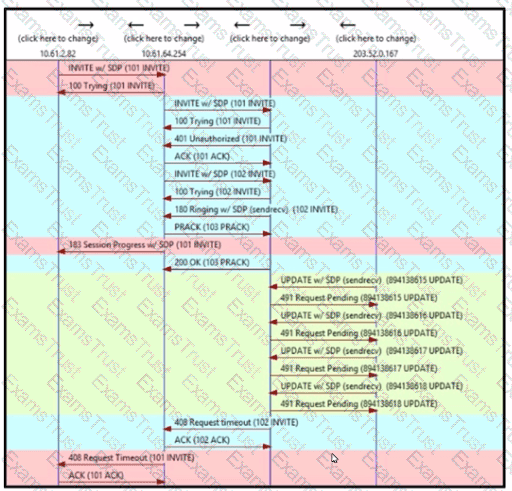
Refer to the exhibit. Calls from users to the PSTN in an organization get disconnected with a 408 Request Timeout when the called party is unavailable to pick up the call. Which solution must be used to resolve this challenge?